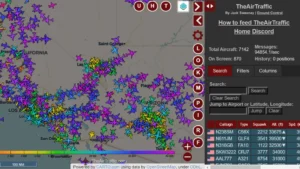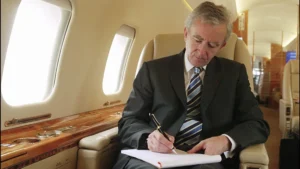Roland Dangerfield, Operations Director of Sentinel Aviation – Reports
I’ve just read an online article in the Washington Post about the 882 private jets that flew into Las Vegas over the weekend for the Super Bowl. It’s the second highest for the Super Bowl (last year’s game in Arizona recorded 931). From all of the press noise, you would think that Taylor Swift’s Bombardier 6000 was the only private jet that travelled there!
Nearly two-thirds of the world’s private jets — 15,000 planes — are registered in the United States, so I am not particularly surprised by the Super Bowl statistic.
However, what I am more interested in is the public accessibility of all the information of each private jet flight.
I ask myself the question: Is this a breach of privacy or is it of public interest?
Over the years, both as a former business jet pilot and more recently the founder of Sentinel Aviation, I have flown members of Royal Families, Politicians, film and sport stars. I am therefore more than aware of the importance of confidentiality, security and privacy demanded by my clients.
But I want to stay subjective and look at both sides of the argument.
Stalking and Harassing Behaviour
Taylor Swift’s attorneys (a Washington law firm called Venable) have recently threatened legal action against a University student called Jack Sweeney who runs social media accounts logging and tracking the private jet flights of her and other billionaires, politicians, Russian oligarchs and other public figures. By the way, the accounts use publicly available data from the Federal Aviation Administration and volunteer hobbyists who can track the aircraft via the signals they broadcast.

Jack Sweeney (image courtesy of Jack Sweeney)
Venable wrote to Sweeney a cease-and-desist letter saying Swift would “have no choice but to pursue any and all legal remedies” if he did not stop his “stalking and harassing behaviour.”
Sweeney’s accounts had caused Swift and her family “direct and irreparable harm, as well as emotional and physical distress,” and had heightened her “constant state of fear for her personal safety,” the lawyer, Katie Wright Morrone, wrote, according to a copy of the letter sent to the home of Sweeney’s parents.
“While this may be a game to you, or an avenue that you hope will earn you wealth or fame, it is a life-or-death matter for our Client,” Morrone wrote. She added that there is “no legitimate interest in or public need for this information, other than to stalk, harass, and exert dominion and control.”
Asked whether Swift’s representatives knew of any evidence that stalkers had used the jet-tracking accounts, Tree Paine, a spokeswoman for Swift, said: “We cannot comment on any ongoing police investigation but can confirm the timing of stalkers suggests a connection. His posts tell you exactly when and where she would be.”
This Information is Already out There
Sweeney said that he saw the letter as an attempt to scare him away from sharing public data. The accounts offer only an incomplete sketch of which cities Swift might be in, similar to the public schedules for her concerts or any NFL games she might attend, he said. And the letters, he added, were sent to him at a time when she faced criticism over her flights’ environmental effects.
“This information is already out there,” he said. “Her team thinks they can control the world.”
The December letter from Swift’s attorney states that Sweeney’s actions are “in violation of several state laws” but does not specify them. The letter does, however, cite nine anonymous Instagram comments saying the account is “scary,” “pathetic,” “weird,” “invasive” and “dangerous” “stalker behavior,” among other things.
The letter says Sweeney is “notorious for disregarding the personal safety of others in exchange for public attention and/or requests for financial gain”.
After receiving the letters, Sweeney said he asked for help from the Electronic Frontier Foundation, a digital rights group, which sent his request to a list of attorneys. James Slater, a Florida lawyer who specializes in First Amendment and internet speech issues, responded on Sweeney’s behalf to the Venable letter.
Slater wrote that Morrone had not identified any legal claim, that the jet information posed “no threat” to Swift’s safety and that Sweeney’s account had “engaged in protected speech that does not violate any of Ms. Swift’s legal rights,” according to a copy reviewed by The Post. Slater said he has yet to receive a response.
In an interview, Slater said he thought the Swift attorney’s letters were “hyperbolic and unfounded” and sent in hopes that Sweeney would “just delete everything and do what they said.”
“This isn’t about putting a GPS tracker on someone and invading their privacy. It’s using public information to track the jet of a public figure,” he said. “This is their means to try to quash a PR issue and bully my client to have the bad coverage die down.”

A screenshot from Jack Sweeney’s website TheAirTraffic.com
Around the time of the December letter, Facebook and Instagram disabled the accounts Sweeney had created to track Swift’s air travel, saying they broke the platforms’ privacy rules, he said. He began posting those updates onto accounts on Facebook and Instagram that he uses to log the travel of planes used by a range of stars, called Celeb Jets. Then, last month, Morrone sent a second letter saying his posts about Swift’s aircraft constituted “harassing conduct.”
Assassination Coordinates
Swift is not the only celebrity to come up against Sweeney. His accounts sparked a free-speech debate in late 2022 when X, formerly Twitter, banned Sweeney for sharing what the platform’s owner, Elon Musk, said were his “assassination coordinates.” The accounts don’t say who travels on the aircraft or where they go once the planes land.
When Musk purchased Twitter (now X) in 2022, he vowed in the name of free speech not to take action against Mr Sweeney’s @elonjet tracking account.

Elon Musk’s private jet on a runway in Beijing last year (image courtesy of Getty Images)
In a matter of weeks, however, Mr Musk reversed course, banned the account and threatened to sue, claiming that @elonjet resulted in a stalker tracking him down and climbing on top of his craft when his small child was inside. Musk claimed “that the tracker was a direct personal safety risk.” Actually, Police later identified a member of Mr Musk’s security team as a suspect, and said that Mr Sweeney’s account had nothing to do with the incident.
In a series of online messages, Musk offered 19-year-old Jack Sweeney $5,000 to stop tracking his private jet flights. The billionaire Tesla founder cited safety concerns, and Sweeney countered, asking for $50,000! Sweeney said no money was ever exchanged.
Mr Sweeney now runs an account that tracks Mr Musk’s jet with a 24-hour delay, in order to comply with a site rule banning real-time location tracking. He also runs accounts on several social media sites keeping track of planes owned by Kim Kardashian, Jeff Bezos, Bill Gates, Mark Zuckerberg, Donald Trump and others.
Corporate Espionage and Violence
And it’s not just business magnates, celebrities and politicians who are vulnerable. Anyone using a private jet is sharing information transmitted through the plane’s black box. For safety reasons, Automatic Dependent Surveillance–Broadcast (ADS-B) technology transmits GPS coordinates, altitude, ground speed and other data to air-traffic controllers and surrounding aircraft—but it also gives rise to dangers ranging from corporate espionage to violence.
This is akin to driving on the motorway and having anybody pick up and track your licence plate, explains Doug Carr, senior vice president of safety, security, sustainability and international affairs for the National Business Aviation Association (NBAA). “This isn’t just about lifestyles of the rich and famous. It’s about basic security and not being able to track people in real time—which, by the way, is illegal anywhere else.”
The issue came into focus a decade ago, when a restaurant-supply firm CEO, who used aircraft to conduct business, was cyber-stalked and tracked by competitors. Then there were the wounded army veterans who were followed and met by anti-war protestors at their home airports. Martha King, who runs pilot-training academy King Schools with her husband, John from its headquarters in San Diego, California, had several unstable “fans” harassing her from out of state. One showed up unannounced and threatened her. “Privacy sounds abstract, but it got personal for us quickly,” says King. “Now, we’re more cautious flying into unknown airports.”
FAA – Help is at Hand
The FAA is trying to help. After ADS-B became mandatory in January of 2020, the agency created several programs that allow jet operators to opt out of sharing tail numbers, helping to conceal passenger identities. Many private owners signed up for the Limited Aircraft Display Data (LADD) program, but sources that don’t use FAA data aren’t obligated to obey those restrictions and can still publish the information emitted from a jet’s transponder.
The FAA moved to fix that loophole by creating a way to temporarily disguise a jet’s tail number through the Privacy International Civil Aviation Organization Address Program (PIA). But joining the program is significantly more complicated than signing up for LADD, requiring physical modifications to the transponder and temporary call-signs—and when it comes to the latter, “you’d likely need to change that code on a routine basis,” says Heidi Williams, NBAA’s director of air traffic services. Besides, the new codes are not recognised outside of US airspace.
As we’ve seen from broader celebrity culture, if there’s enough public interest, the trackers will find a way—the FAA can’t stop enthusiasts or paparazzi from physically watching jet traffic at a local airport and then sharing those tail numbers, for example. Spokesperson Tammy L. Jones says the agency is expanding PIA for US-registered aircraft to include FAA-managed international airspace, but that no mechanism currently exists to encrypt secondary surveillance and communication technology, and that modifying the next ADS-B generation could be a decade away.
Meanwhile, the NBAA is in talks with trade associations in Canada and the European Union, which account for 40 percent of global business-aviation activity, to create an international PIA-type program. But universal adoption would require “a conversation in every part of the globe on what this program means, and how it would interface with air-traffic-control systems,” says Carr. All of which leaves pilots like John King, whose wife was physically endangered, frustrated, angry and wondering: “Why should we have to give up our privacy whenever we get on an airplane?”
Environmental Responsibility
Private jet flights are routinely criticised for their disproportionately high impact on climate change, and Sweeney’s accounts have often been used to name and shame their most famous passengers. In 2022, the accounts were cited in an analysis that estimated that Swift was the biggest celebrity carbon dioxide polluter of the year.
Swift’s publicist responded that the analysis was flawed because her jet was often loaned out to other people. Paine told The Washington Post that Swift bought more than double the carbon credits needed to offset her travel before her recent tour kicked off.
Using data from a popular Twitter account that tracks celebrity jet movements based on public information, the report stated that planes affiliated with celebrities emitted an average of more than 3,376 metric tons of CO2 — roughly 480 times more than an average person’s annual emissions.
But this must be read in context. Private aviation is responsible for just 2% of aviation’s total carbon output, and aviation is just 2.1% of overall human-induced carbon emissions, meaning that private jets emit 0.04% of global human-induced CO2 emissions. However, the industry is using platforms, such as Davos, to highlight ways private flyers can do their part to reduce emissions. Jet Aviation’s Zurich location is offering attendees Sustainable Aviation Fuel via its Book & Claim program. Sustainable Aviation Fuel, or SAF, reduces aviation CO2 emissions by up to 80%. Book & Claim allows flyers to buy SAF even in locations where it’s not available.
“We are committed to providing sustainable choices for our customers,” says Jet Aviation President, David Paddock, adding, “We also recognise that achieving a more sustainable future is not just about the services we provide, but how we provide them and how we do business in the communities in which we operate. Book & Claim allows anyone traveling to and from Davos to support sustainability and grow the market for sustainable aviation fuels.”
The Climate Investment Fund
Just to be clear, Sentinel Aviation commits to defining a long term sustainable future for the private aviation sector. We aim to be fully carbon neutral across our entire business by 2025 – reducing climate impact of our flying.
To this end, we are partnered with Pelorus Foundation, supporting their Climate Investment Fund which funds grassroots projects that balance carbon emissions. Our contributions to this fund demonstrate just one of our actions and commitment towards a future of sustainable travel.
When you fly with Sentinel Aviation, you have the opportunity to balance your carbon emissions through Pelorus Foundation’s Climate Investment Fund.
What Would the World Look Like Without Business Aviation?
When thinking about business aviation, critics often fail to consider that the aircraft in question are also used for medevac flights that transport patients from one location to another where they can receive the care they need. Or the air ambulance flights that move accident victims from rural areas to hospitals in order to quickly receive life-saving treatment.
There are also a number of organisations that coordinate the use of business aircraft for humanitarian purposes. According to the European Business Aviation Association (EBAA), business aviation operates 70 life-saving or medical flights per day on average.
In Summary
Travel by privately owned aircraft, whether jets, props or helicopters will continue. But with the full support and backing of the private aviation industry, we must always be pro-actively seeking ways and methods of reducing the sector’s carbon footprint – by both encouraging and embracing new technologies and also trying to maximise efficiencies.
With regards to the ‘privacy vs. public interest? We are all entitled to a certain level of privacy, however famous or wealthy. And let us remember, the importance of security is not just for the individual but the travelling entourage as well as the crew of the plane. Conversely, a lot of the fame (especially that of the Celebs) is generated by a PR machine that includes constant social media activity – they demand the attention of the public! Perhaps the Celebs, in particular, need to live with it; ‘it’s part and parcel of the job’ perhaps?
But there is a middle ground that I am an advocate of. As mentioned earlier in my article, Jack Sweeney still has an account that tracks Elon’s jet. But there is a 24-hour delay, in order to comply with a site rule banning real-time location tracking. Surely, both parties are now happy?
The other option for those that wish to travel privately, is do what the LVMH Chairman Bernard Arnault does.

Bernard Arnault on his Bombardier Global (image courtesy of Marc Deville/Getty)
In 2022 he eventually got tired of all the glare and sold his Bombardier Global, switching to charter flights with private passenger manifests. AND, signing off, this is where Sentinel Aviation steps in!
Get in touch
© Sentinel Aviation. Company No. 09400896. Vat No. 221163359.
All rights reserved. Created by AJA Design.
